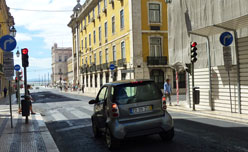Lisbon driving – The Baixa-Pombalina area of Lisbon
The Pombalina area of old Lisbon, also referred to as Baixa-Pombalina, is situated just north of Praca do Comercio in Lisbon downtown.
This old part of Lisbon is a rather charming, if slightly run-down neighbourhood, which adds to its authenticity.
The streets are a perfect grid and should, in theory, be easy to navigate, but they are not. As Lisbon is developing, the Baixa-Pombalina consist of mostly one way streets and it is notoriously difficult to arrive at a specific destination within the Pombalina part of Lisbon by car.
Drivers of private cars are lead through the area without many other possibilities than following one or two predestined routes – either up to the Rossio Square/Martim Moniz square or through narrow streets to Chiado.
Parking is difficult unless you make use of the quite numerous underground facilities.
Baixa-Pombalina in Lisbon downtown
The Baixa-Pombalina area in Lisbon takes its name after the famous Marquess of Pombal – in fact the full title granted was 1st Count of Oeiras, 1st Marquess of Pombal.
The first Marquess in a long line was Sebastião José de Carvalho e Melo. In 17th century Portugal, the Marquess of Pombal was comparable to a prime minister.
When driving in Baixa Pombalina, the influence of the Marquess Pombal is one of the areas most striking features.
Houses on the street of Rua de Prata (originally the silver merchant’s street) are not yet to the same show standard as for instance the 2011 inaugurated Hotel Internacional Lisboa in Rua de Betesga.
One can argue that Lisbon should stay with its unique slightly tatty look in places – or it would not be Lisbon. There is – still – a quite breath-taking mix of old and new. In almost every street in Baixa-Pombalina, for instance, you can find shop fronts, which look like a movie-set from a 1950′s film.
As for shopping in Lisbon Baixa-Pombalina, the wide main walking street Rua Augusta is the preferred choice for most visitors. Here you find a large variety of shops and entertainment.
In the slightly narrower side-streets, Portuguese cuisine is served outside on the pavement all day – often at tourist prices. Venturing into a less buzzy area for lunch may sometimes carry a lot of benefits with it.


